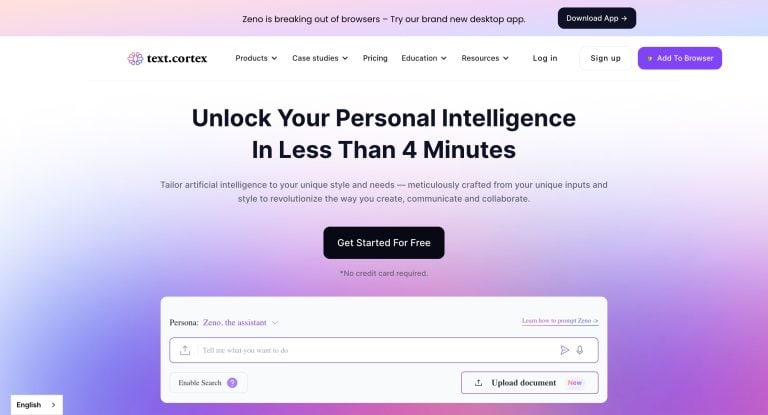Honest Review of Julius AI – is it worth it?
Ever felt so overwhelmed by the volume of data present before you for analysis? Are you struggling to turn numbers into clear insights to no avail? Well, you’re not alone and this post has come bearing good news today.
Imagine having a friend who’s good at sorting out loads of data, making sense of it all, and even tossing in some cool charts to show you what is what.
That’s Julius AI, a data analysis software. It’s here to take the headache out of dealing with numbers, graphs, and all those tricky bits that make your brain go hot.
So whether you’re drowning in spreadsheets for work, or school, or just trying to make sense of some stats for fun, Julius AI has your back.
We are going to walk you through what it does, how it can make your life easier, and why so many people out there think it’s pretty awesome.
Let’s embark on this Julius AI review journey together!
What is Julius AI?

Julius AI is a computational AI tool designed to simplify data analysis by enabling users to interact with their data through a chat interface.
It’s like having a conversation with your data files, where you can ask questions, request insights, or command the creation of visualizations and reports, all in natural language.
This innovative approach makes data analysis more accessible and less intimidating for users of all skill levels, from professionals to students.
The platform offers a range of features aimed at enhancing the data analysis process, including the generation of charts and graphs for smooth data visualizations, and insights.
All these are through asking direct questions to the data, advanced analysis capabilities like modeling and predictive forecasting, and even problem-solving for math, physics, and chemistry questions.
Julius AI can generate polished analyses and summaries, making it easier to present data-driven insights.
It supports a wide variety of data sources, such as spreadsheets in different formats, Google Sheets, Postgres databases, and more, ensuring flexibility in handling data.
What Does Julius AI Do?

Julius AI transforms the way users interact with and analyze their data by offering a platform where they can essentially “chat” with their data files to gain insights, create visualizations, and solve complex problems.
Here’s a breakdown of what Julius AI does:
1. Data Visualization
Julius Ai enables it users to easily generate smooth and informative charts and graphs. By simply asking Julius AI, you can visualize your data in a more comprehensible and visually appealing way, making it easier to communicate findings.
2. Insight Generation
You can ask Julius data analysis tool direct questions about its data, and it will provides you with answers. This feature makes it much simpler to uncover hidden insights without the need for complex queries or extensive data analysis skills.
3. Advanced Analysis
Beyond basic queries, Julius AI can perform more sophisticated data analysis tasks, including modeling and predictive forecasting. This allows users to explore future trends and make data-driven predictions.
4. Problem Solving
This software is not just about data analysis; Julius AI also has capabilities to help solve mathematical, physics, and chemistry problems, making it a versatile tool for students and professionals alike.
5. Report Generation
Julius AI can synthesize data analyses and summaries into polished reports, saving users time and effort in communicating their findings to others.
By simplifying these processes, Julius AI aims to make data analysis more accessible to everyone, regardless of their technical background.
It’s particularly useful for people who need to analyze data quickly and efficiently without getting bogged down by the complexities of traditional data analysis tools.
Who is Julius AI Best For?

In essence, Julius AI is best for anyone looking for a straightforward, conversational way to analyze and interact with data without the expensive learning curve typically associated with traditional data analysis tools.
Its broad appeal lies in its ability to democratize data analysis, making it accessible and useful for a diverse audience. Here’s a look at who might find Julius AI especially beneficial:
1. Students
Students across disciplines like business, science, engineering, and humanities can use Julius AI to analyze data, solve complex problems, and visualize results whether they are dealing with homework, projects, or research
The existence and availability of this software in the students world makes learning less easier, more interactive and insights more accessible.
2. Educators and Academics
Another set of people who can use Julius AI are the educators and academicians. Professors, teachers, and researchers alike can leverage Julius AI to simplify data analysis, create visual aids for teaching, and explore data for academic papers or studies, enhancing both their teaching and research efforts.
3. Business Professionals
Also, analysts, marketers, financial professionals, and managers across various industries can use Julius AI to generate ideas and insights from business data, forecast trends, and create reports or presentations.
Thus, helping them to make informed decisions and strategies for the betterment of their business organization and actualization of better policy models.
4. Data Enthusiasts
Individuals with a personal interest in data analysis, from hobbyist projects to personal finance management, can find Julius AI’s user-friendly interface and powerful analysis capabilities a great way to engage with their data.
5. Startups and Small Business Owners
With limited resources and possibly limited data analysis expertise, startups and small business owners can use Julius AI to gain valuable insights into their business data, customer behavior, and market trends without needing to invest heavily in specialized personnel or software.
Julius AI Key Features
Be informed that Julius AI comes equipped with many features that are specially designed to simplify its users data analysis process.
These features are geared towards making complex data analysis tasks more accessible for users of all skill levels.
Some of these key features are:
1. Chat with Your Data
One of the top features of Julius software is that its chat with your data. This feature stands at the core of Julius AI, thereby enabling you to interact with your data through natural language.
Instead of navigating through complex data analysis software, you can just simply type questions or commands, as if you are chatting with a human, and you will receive insights, answers, and analyses directly.
Without a doubt, this conversational approach makes data analysis more approachable and efficient.
2. Create Graphs and Visual Representations
Similarly, Julius AI create graphs and disual data representation which is very crucial for understanding complex datasets and communicating findings.
Being one of this software features, the app allows you to quickly generate a variety of charts and graphs by commanding the AI to do so.
This can include everything from simple bar charts to more complex scatter plots, helping users to visualize trends, outliers, and patterns in their data.
3. Build Forecasting Models
In the same vein, forecasting is essential for predicting future trends based on historical data and as such, Julius AI is also fusioned with forcasting models.
This data analysis software enables users to build forecasting models without needing deep statistical knowledge.
That is to say, by providing the data and specifying the forecasting goal, you can receive predictive insights that are crucial for planning and decision-making processes in various fields.
4. Perform Advanced Analysis
Beyond basic queries and visualizations, Julius AI is also capable of performing more sophisticated analyses.
This includes regression analysis, cohort analysis, and other advanced statistical techniques that can uncover deeper insights and relationships within the data.
This feature is particularly valuable for users needing to conduct thorough data investigations for academic, scientific, or business purposes.
5. AI Answer Engine
At the heart of Julius AI is an AI-powered engine that processes users’ queries to provide accurate and relevant answers.
This feature leverages the latest advancements in artificial intelligence to understand natural language prompts, analyze the underlying data, and generate insightful, easy-to-understand responses.
Thus, making it possible for users to get quick answers to complex data-related questions.
How to Use Julius AI to Analyze Datasets
Using Julius AI to analyze datasets can fast track your data analysis process, turning complex information into understandable insights.
Here’s a simple step-by-step guide on how to get started:
1. Create an Account
First things first, head over to the Julius AI website and sign up for an account. This step is usually straightforward – just provide the necessary details like your email address, create a password, and you’re good to go.
2. Adjust the AI Settings
Once you’re logged in, take a moment to familiarize yourself with the dashboard and settings.
Julius AI offer customization options to suit the AI’s responses based on your specific needs or preferences.
This involve setting your industry, the complexity of analysis you’re looking for, or even the type of data you’ll be working with.
3. Upload a File
Next, you’ll want to upload the dataset you wish to analyze. To analyze your data, you’ll need to upload it to Julius AI.
Navigate to the section where you can upload files, which is typically clearly marked. Select the file you wish to analyze and upload it to the platform.
Julius AI supports a wide range of data file formats, including spreadsheets (.xls, .xlsx, .csv), Google Sheets, and more.
4. Give Julius a Command
With your data uploaded, it’s time to start the conversation with Julius. Simply type in what you’re looking to find out from your data in the chat interface.
You can ask for specific analyses, like trends over time, comparisons, or predictive insights. The AI is designed to understand natural language, making it easy to interact with.
5. Analyze & Visualize the Data
Julius AI will process your request and provide you with the analysis or visualization you asked for.
It could be graphs showing trends, pie charts for distributions, or predictive models forecasting future possibilities.
Take your time to review the insights, and if you need further clarification or additional analyses, just keep the conversation going.
How Much Does Julius AI Cost?
Julius AI offers a versatile pricing structure and it is aimed to serve a broad audience, from novices in data analysis to seasoned professionals in need of in-depth features and dedicated support.
Julius AI pricing model can be categorized as follows:
1. Free Plan
The free plan provides an opportunity to explore Julius AI’s capabilities with $0, and it allows up to 15 messages per month.
This plan is perfect for those who are curious about the platform and wanting to test its functionality before opting for a more comprehensive package.
2. The Basic Plan
The basic plan cost $17.99 monthly (or $149.99 annually) and it offers up to 250 messages per month, along with unlimited exports of datasets, visualizations, and dashboards.
This plan suits those who have moved past the exploration stage and need a more substantial toolset for their data analysis tasks.
3. The Essential Pan
This plan offer unlimited messaging and data export capabilities, it costs $37.99 per month and it has a higher significant discounts on its annual payments.
4. The Pro Plan
The Pro plan also offers unlimited messaging and data export capabilities and it is priced at $49.99 monthly.
This plan provides access to premium customer support and early access to new features, making it ideal for powerful users and professionals who depend heavily on data analysis for their work.
Julius AI Pros
1. Accessibility
Julius AI makes data analysis accessible to users with varying levels of expertise. Its user-friendly interface allows even those with minimal background in data science to perform complex analyses.
2. Versatile Features
The platform offers a wide range of features, including data visualization, forecasting models, and an AI answer engine, making it a comprehensive tool for different data analysis needs.
3. Affordable Pricing
With a free plan and several paid options that provide substantial value, Julius AI caters to individuals and businesses with different budgetary constraints.
4. Efficiency
Julius AI can significantly reduce the time and effort required to clean data, analyze datasets, and generate reports, turning hours of work into minutes.
5. Support for Multiple Data Sources
The platform supports a variety of data file formats, including spreadsheets and databases, ensuring compatibility with most data analysis workflows.
Cons
1. Learning Curve
While Julius AI is designed to be accessible, users may still need to familiarize themselves with specific commands and the best ways to interact with the AI to maximize its capabilities.
2. Limited Free Plan
The free plan’s message limit may be too restrictive for users with more than casual or minimal data analysis needs, necessitating an upgrade to paid plans.
3. Dependence on Clear Instructions
The accuracy and usefulness of the analysis can depend heavily on how well users articulate their questions or commands to the AI, which might require some trial and error.
4. Data Privacy Concerns
Although Julius AI states it employs strict data privacy measures, potential users may still have concerns about uploading sensitive or proprietary data to an online platform.
5. Internet Dependency
Being a cloud-based service, Julius AI requires a stable internet connection, which might limit its use in areas with poor connectivity or for users who prefer offline analysis tools.
Julius AI Alternatives
The following softwares are juliu AI alternatives and each of these alternatives serves different aspects of data handling, analysis, and visualization, catering to varied user needs from presentation enhancement down to influencer marketing analytics.
These alternatives include:
1. Tableau
Tableau is a powerful data visualization tool that enables users to convert complex data sets into understandable and interactive visuals.
It’s widely appreciated for its user-friendly interface and the ability to handle large volumes of data, making it a go-to for businesses and data analysts who aim to make data-driven decisions.
2. Excel Chart Animation
While not a standalone software, Excel Chart Animation refers to leveraging Microsoft Excel’s dynamic chart features to animate data over time or through specific triggers.
This feature is particularly useful in presentations or reports where showing data trends and changes dynamically can significantly enhance understanding.
Excel’s robust spreadsheet functions combined with chart animation capabilities make it a practical choice for those already familiar with the Microsoft ecosystem.
3. Microsoft Power BI
Microsoft Power BI is a suite of business analytics tools that offers comprehensive data analysis and insights.
It allows users to pull data from wide-ranging sources, transforming it into interactive dashboards and reports.
Power BI is known for its integration capabilities, especially within the Microsoft suite, making it a strong contender for enterprises looking for deep data insights and seamless office suite integration.
4. Thinkcell
Thinkcell is an add-on for Microsoft PowerPoint and Excel, focusing on enhancing presentation capabilities through sophisticated chart creation and data visualization.
It’s designed to streamline the process of making complex charts, saving time for consultants, analysts, and anyone needing to present data compellingly.
Thinkcell bridges the gap between data analysis and presentation, offering tools that simplify visual communication.
5. Polymer
Polymer is a Google-developed library for building web applications using Web Components.
In the context of data, Polymer can be used to create custom, reusable web components for dashboards or data visualizations, enabling developers to build highly interactive and dynamic data-driven applications.
Polymer is suitable for teams looking to leverage web technologies for custom analytics platforms.
6. CreatorIQ
CreatorIQ is a cloud-based platform designed for influencer marketing analytics. It provides agencies and brands with tools to discover influencers, manage campaigns, and measure the impact of their influencer partnerships.
With a focus on social media data, CreatorIQ helps marketers optimize their strategies by offering insights into audience engagement, campaign performance, and ROI.
Is Julius.AI Safe?
Yes, Julius.AI is designed with user safety and data privacy in mind. It uses strict access-control measures, meaning each user has access only to their own data.
The environments where the data is processed are securely isolated for each user. Moreover, Julius.AI ensures that your data is completely erased from their servers when you choose to delete it within the app.
They’re committed to maintaining high standards of data privacy and security, aligning with their policies to protect user information.
Julius AI Review: Final Verdict
Julius AI is a powerful tool for data analysis, bringing the complexities of data science to a more accessible level for a wide range of users.
Its ability to chat with your data, create intricate graphs and visualizations, and perform advanced analysis, including predictive forecasting, positions it as a valuable asset for anyone looking to extract insights from data.
By and large, Julius AI user-friendly interface, combined with powerful analytical capabilities, makes it a compelling choice for anyone looking to leverage their data for insights, decision-making, and increased efficiency.
Whether you’re in healthcare, academia, marketing, or any field that relies on data, Julius AI has the potential to enhance your analytical capabilities.
Frequently Asked Questions

Is Julius AI free?
Generally, Julius AI is not free but it offers a free plan that allows users to send up to 15 messages per month.
This plan is perfect for those who want to explore the platform’s capabilities before deciding on a paid subscription.
Can Julius AI do statistical analysis?
Yes, Julius AI is capable of performing statistical analysis. It utilizes AI to interpret data, create graphs and visualizations, and even carry out predictive forecasting, making it a versatile tool for statistical analysis among other functions.
Who is Julius AI founder?
Rahul Sonwalkar is the founder of Julius AI. With a vision to simplify data analysis and make it more accessible to a wide range of users.
Rahul and his team at Julius AI have developed a platform that leverages the power of AI to offer advanced data analysis capabilities.
Through Julius AI, Rahul aims to democratize data science, enabling users from various fields and with different levels of expertise to derive meaningful insights from their data.


